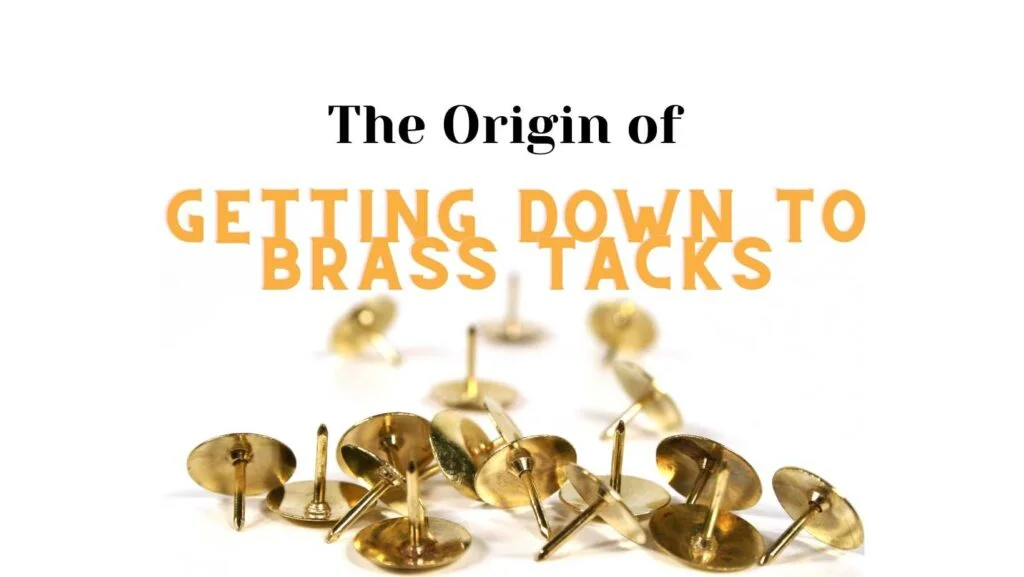You have to be the change to bring the change.

The Origin of the Phrase “Getting Down to Brass Tacks”
Our content is reader-supported. We may earn a commission if you make a purchase through one of our links.
While this idiom may seem very casual or unimportant to you, shockingly, it is the topic of political discussions in some countries. For several people, finding out the origin of getting down to brass tacks is not just a passing fancy but an entire quest, and it’s a hard row to hoe!
So, to make things a little less chaotic and clearer for the English enthusiasts, I have put in my two cents in this article. Let us get down to the brass tacks!
What does ‘Getting Down to Brass Tacks’ Mean?
‘Getting down to brass tacks’ is a common idiom that means to consider or discuss the most important details of a topic or subject. It is used often in the American language and is a good way to get your point across while sounding formal and respectful. The phrase is also a classic use of metal language.
This brings us to our main topic-where did ‘getting down to brass tacks’ come from? It seems to have been here forever; however, like every other phrase, it must have a history. It’s time we discuss this mystery!
The Proposed Theories for the Origin of Getting Down to Brass Tacks
American History
Although it seems old, the usage of ‘getting down to brass tacks’ surfaced only in the 18th century. In January 1863, it was published in a Texas newspaper, the Tri-Weekly Telegraph:
“When you come down to ‘brass tacks‘ – if we may be allowed the expression – everybody is governed by selfishness.”
While the quotation seems somewhat old, its meaning is pretty much relevant even today; people do seem to be quite self-centered. However, we will get down to the brass tacks of this topic some other day.
Here, you should take notice of the mention of Texas; this newspaper print is what makes most believe that this idiom has risen from America. Another fact relating it to the United States is Abraham Lincoln’s death on 14th April 1865. A great coffin worthy of his status had to be crafted, and so, it was made using brass tacks. The coffin was described in the following words:
“The outside of the coffin is festooned with massive silver tacks representing drapery, in each fold of which is a silver star. There are eight massive handles to the coffin, four being placed on each side. A row of silver tacks encircles the entire top of the coffin, while a silver plate, encircled by a shield formed of tacks of the same material, occupies a central position on the top lid…”
Gunstocks Decoration in the Wild West
Another theory indicating this idiom’s origin is the decoration of Gunstocks with brass tacks. As an old practice, brass tacks were used to enhance Gunstocks’ appearance in the American West. Gunmen would put brass tacks into the stocks of their guns as a representation of each of their victims.
In simpler terms, the number of brass tacks on a shooter’s firearm showcased their skill at taking the life of their victim. Therefore, ‘getting down to the brass tacks’ referred to getting to know the real deal about that individual.
Furniture Decorations
Next comes the furniture decoration theory, which says brass-headed nails are used in fabric fixings in the furniture trade due to their imperviousness to rust and decorative appearance. Such brass tacks were frequently used in Tudor furniture; however, their usage is long pre-dated. Why wait hundreds of years to coin a phrase from this source?
Those who favor this explanation argue that to reupholster a chair, the upholstery must remove all the fabric covering and tacks; only then can they reach the chair’s basic frame. However, doesn’t this make tacks the first thing to be removed, instead of the last, most important one?
Haberdashery Trade
This refers to the haberdashery trade that used brass tacks for measuring cloth. It relies on the notion that for greater accuracy, instead of measuring a yard of material with the rough and erroneous method of holding it out at an arm’s length, it was measured between brass tacks set on the shopkeeper’s counter.
However, this brings us to our question again-how does that relate to coming to the basics of a topic? Perhaps when you got down to the brass tacks when measuring cloth, only then could you know the accurate measurements. The same idea might have been applied to other areas of discussion, resulting in the coining of the popular phrase.
Other Theories
Several other hypotheses have been proposed since. Wyandot (Ohio) Pioneer insisted that the origin of getting down to brass tacks is from brass tacks’ use in hardware stores and coffins. On 14th May 1868, he said:
“Bring things right down to brass tacks in all the affairs of this life and the millennium is not far away,” the story read. “Brass tacks — emblem of the only inevitable and last friend, the undertaker. Studded over our final ligneous adornment, brass tacks are suggestive of stern, inexorable reality. … Brass tacks have equalized all human earthly conditions. The peer and peasant, king and common, old and young, wise and otherwise, lie down in a common mortality from which there is no escape.”
Other theories relate brass tacks to their use in boots, rivets on boats, tacks put on chairs as pranks, and taxing of brass tacks during various times. Another hypothesis suggests ‘getting down to brass tacks’ is part of the Cockney rhyming slang, meaning facts. And that ‘tacks’ is simply rhyming with ‘facts’ (facks), hence the expression. However, most rhyming slang coinages are limited to Australia and the United Kingdom only, so again, this suggestion is not very useful.
The Conclusion
Numerous theories about ‘getting down to the bass tracks’ relate it to numerous origins. These include brass tacks’ use in coffins, as gunstocks’ decorations, tacks as furniture and fabric fixings decorations, and their application as measuring tools in Haberdashery trading. Moreover, brass tacks’ utilization in boots, boats, pranks, and Cockney rhyming slang is also considered. For me, none of these is equipped with significant explanations or evidence except for one-brass tacks in Haberdashery trading.
Perhaps the material or quality of a piece of fabric holds considerable significance but knowing how much the piece measures has immense importance. Therefore, until I find another more solid explanation, I shall relate ‘getting down to the bass tracks’ to its fabric measuring derivation.




That’s true! The origin of Getting down to brass tacks explained wonderfully!